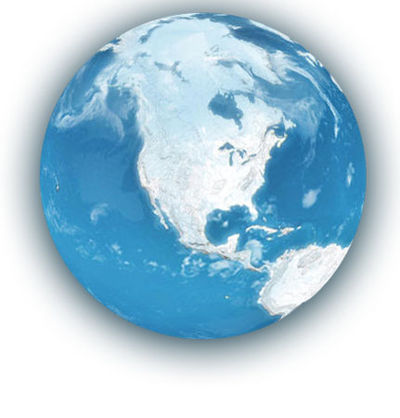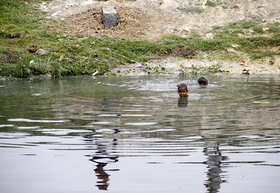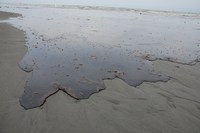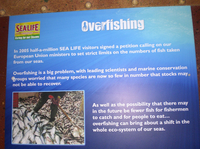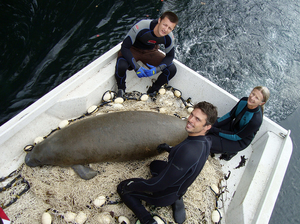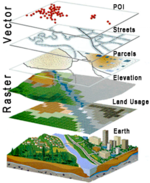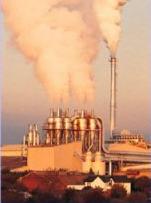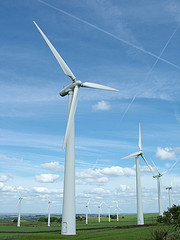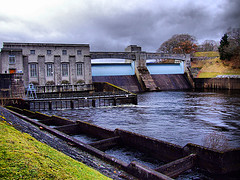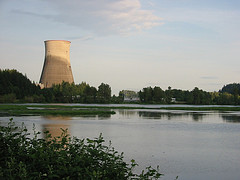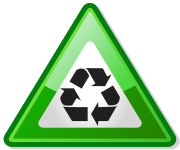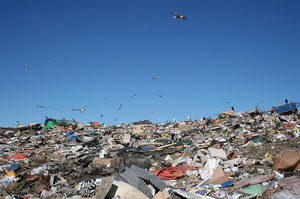DeAnza College/CIS2/Summer 2011/Group 4
| Students @ Work - a student collaborative writing project. Help us by providing feedback on the Discussion page. |
Contents
Environmental Sustainability
With the human population now over six billion people, the modern world has encroached on the ability of the environment to operate at optimum efficiency. The health and welfare of all living things is based on the sustainability of the environment. With continued population growth and an expanding global economy, developing and implementing modern technologies that continue to keep a wide variety of natural environments (such as land, water and the atmosphere) viable is becoming an ever more important factor to governments, businesses and to people as a whole. This wiki focuses on land, water and atmosphere environments as well as on man made energy sources and man made waste that have a strong impact on those environments.
Water
Around seventy percent of the Earth's surface is covered by water. It is a substance that no living thing on our planet can do without. With the growing rise of the human population, maintaining water quality is becoming imperative. Pollution destroys aquatic ecosystems from one side while human overfishing devastates it from another. While countries like America proclaim water to be free to the public, in other countries populations are ravaged by water borne illnesses. Every day, water is wasted in some places while at the same time unavailable to people in need elsewhere. People are beginning to see that the way in which water, and the life that lives within it, needs to be managed with much greater efficiency to avoid and/or reverse environmental problems. One tool in creating a sustainable water environment is through the use of technology. The following will explore some of the positive and negative impacts that technology has on water.
Clean water
The number of people that do not have access to clean water is approximately one in eight.[1] This lack of clean water spreads death and disease throughout the globe. However there is hope. Scientists such as Dean Kamen are working on ways to deliver clean water through the use of technology. In a 2008 article, Big Problem, Neat Solution [2] Kamen talks about technology that he is working on to take the most polluted, poisoned sewage and convert it into clean pure water. There are still challenges ahead for the project which are mainly cost related. Right now the machines cost upward of $100,000. Kamen's goal is to be able to manufacture the machines for around $2000, which would allow this beneficial technology to be more accessible to communities in need of clean water.
While Kamen's plans are still being developed, one of the best ways that people can help others obtain clean water is through the internet. The internet has made it much easier for people to learn about clean water efforts and to find out how they can provide money and support to help clean water projects. Doing a search on clean water yields many sites committed to providing clean water. Sites such as charity : water, Clean Water Action, and Give Clean Water allow people to donate money and/or time to help provide clean water to others around the world.
Just as important as clean fresh water is clean sea water. The oceans provide 99 percent of the Earth's living space and it has been estimated that death and disease caused by polluted coastal waters costs the global economy US$12.8 billion a year. [3] Technologies that are very important to humanity can have devastating effects on the world's oceans. Everyday factories and automobiles create pollution that get washed out to sea. As the human population grows ever larger, more and more human waste is dumped into the ocean. Technologies that extract oil from the ocean floor have recently highlighted the negative effects that technology can play on our our oceans. In 2010 the British Petroleum Deepwater Horizon oil spill became one of the worst disasters to ever hit the world's oceans. Estimates show that this man made disaster has spilled between 17 and 39 million gallons [4] of oil into the Gulf Coast. There are people that are using technology to fight such disasters. One of the most prominent is actor Kevin Costner. Costner has spent over twenty million dollars developing ships that skim polluted oil from the water's surface, extract the oil, and return only the clean water and they are now being used by British Petroleum to help clean up the Gulf Coast disaster. [5]Overfishing
Aquatic ecosystems are nearly as important to the increasing human population as is pure fresh water. In an article by Steven Hedlund, Hedlund cited a 2008 United Nation's report that stated that global seafood consumption topped 17 kilograms per capita in 2007 and 2008. [6] This emphasizes how important the ocean's bounty is to the world's human population. Yet without sustainable fishing this bounty will soon disappear.
Technology has played quite a sinister role in the plight of overfishing. Through sophisticated technologies such as sonar, large schools of fish can be easily pinpointed and harvested. [7] Large corporations in the fishing industry can now push their fishing fleets ever further throughout the oceans hastening the decline of many species of marine life. Overfishing is a problem which is not easily solved. It is an area that is hard to regulate since no country can easily deny others access to any part of the world's oceans. However there is a positive role that the internet can play in helping combat the problems of overfishing. The internet is a great way to quickly inform people of the problems being faced in the fishing industry. Using the internet allows individuals to learn how their actions can help reverse the effects of overfishing. A good place to start is the What Can I Do To Help section of overfishing.org [8] This site gives information to help consumers identify fish that can be sustainably eaten which helps fisheries move away from species that are presently in danger. It also gives advice on how to spread the word on overfishing so that more and more people will be able to exert a greater influence on the fishing industry.Conservation
As shown in the clean water section of this wiki, it can cost a great deal of capital to convert polluted water to freshwater. This is where conservation plays a vital role. There are many changes that people can make every day to use less fresh water so that there is more to go around. Low tech options are available from putting displacement weights in the toilet to adding aerators to faucets so that less water comes through the taps. Other solutions are not much more complex but can also greatly reduce fresh water use, technologies exist to collect rain water or grey water to be re-purposed for tasks such as watering lawns. Computers play an important role in irrigation. Homeowners can install computers that control their sprinkler systems which will save water and lower water bills. There are now sprinkler systems being developed for residential use that will even adjust themselves based upon online weather reports sent to the watering systems. [9]
In matters of aquatic ecosystems the internet is used as a powerful tool to help preserve marine habitats and to reverse damage that has been done to water based environments. The Nature Conservancy has a great website dedicated to protecting and rehabilitating the world's oceans. [10] This website has projects all over the world, partnering with the local communities and businesses. The site informs the viewer with information on why it is important to keep marine habitats stable. Additionally, one can find information on how he or she can help sustain water based environments through daily life choices and/or donate to this cause. While some sites are fighting to preserve aquatic ecosystems around the globe, others focus on just one piece of the puzzle. A great example is the Crystal River National Wildlife Refuge, this websites helps inform the public about it's mission to protect the endangered West Indian Manatee. [11] This website highlights how smaller local programs can create a big impact.Land
The conservation of land is a very hot topic in many areas. People want more land to develop on, but, in many cases, the environment is destroyed in the process. To compensate for this, many governments have set up parks, preserves, guidelines for agriculture and lists of protected plants and animals that are disappearing. The big question is, is that enough? This section covers the conservation of land through parks, environmental planning and sustainable farming practices. All important ways to help save the land we live on and ensure it will be sustained for future generations.
Conservation
Conservation of land is important enough to be an international issue dating back over a hundred years. The National Park even saw it's birth in the United States with Yellowstone National Park, created by an act of congress in 1872.[12] Ever since, countries around the globe have been creating and maintaining National Parks to preserve land and wildlife. The National Parks Conservation Association(NPCA) was established as an independent organization in 1919 specifically for the upkeep and protection of the National Parks of America.
However, the attempt to preserve land doesn't stop at our own borders. The International Union for Conservation of Nature(IUCN) includes over 200 governments worldwide in a collective attempt to provide habitats with much needed protection. The IUCN has thousands of field projects around the world that provide neutral environmental opinions to governments, and are leading experts on sustainable development.[13] But even with hundreds of governments involved, some of these areas of picturesque land are still disappearing.
Environmental Planning
Environmental Planning, sometimes referred to as Urban Planning, is the process of minimizing the environmental effect of construction and urbanization on the environment. It also balances social and political issues along with the environmental factors. With these all in balance, you get a city that is efficient and more environmentally friendly. Even the simple things like the height of a building in a specific area could cause differences in wind patterns that could erode habitats faster. Natural Resource Management, one of the more important environmental aspects of Environmental Planning, focuses on the distribution of natural resources. It helps ensure that the land can support and continue to thrive with what is constructed.
Environmental Planning has become important enough that tools like the Geographic Information System, or GIS, have been developed specifically for this purpose. A GIS map can use information like rainfall, erosion, existing resources, structures and the amount of land cleared to estimate regeneration of the environment over time.[14] GIS maps are an important tool for pitching a project to an environmentally friendly committee or neighborhood.
One step lower is Community Based Natural Resource Management (CBNRM). This is when the community gets involved with things like community gardens, protesting environmentally unfriendly projects, even having gardens and trees in their own back yards. The community plays a bigger role in conservation than most people believe, as De Anza college itself learned when it was told by the community to build lower parking structures than originally planned.
Sustainable Agriculture
Sustainable Agriculture focuses on the use of land efficiently for crops. It ensures that crops grown aren't harmful to the local environment, but also fulfill the need for food. Non-profit groups like Protected Harvest monitor and endorse sustainable crops, providing a seal on products that qualify. Practices like crop rotation have been used for hundreds of years to ensure that crops don't suck the soil dry of specific minerals and nutrients. For example, if soil is getting lower in nitrogen the farmer may choose to plant peanuts, which harbor natural nitrogen producing bacteria. There has even been talk of genetically engineering different crops to host this bacteria, but it's only recently become a feasible option.[15] Crop rotation also helps prevent a buildup of crop specific pests, ensuring large amounts of crops aren't lost to such pests.
Another big issue is soil erosion caused by the processing of land for farming. Some farms grow special soil holding plants to form a barrier and keep the wind from blowing away soil. Repetitive tilling of land can cause dust or loose soil, resulting in more erosion. Another issue is the use of chemical fertilizers which contain salts, these increase the salinity, or amount of salt, in the soil. Excessive salinity can erode away pipes and roads and do not allow most crops to grow very well. Some plants can withstand high salinity soil, but most are noticeably affected even in slightly salty soil. If many plants can't grow in the soil there are less roots to hold it down. Therefore the land is more vulnerable to wind and water erosion.[16]
Soil salinity can be prevented with extensive drainage systems, but to do so, the underground water level must be lowered. This makes many drainage systems expensive and tedious. Another option is strip cropping, where the farmer irrigates every other strip of land, leaving the strips between fallow or uncultivated. This causes the salt to collect more so in the areas where no irrigation is occurring. In these areas of land, salinity resistant grasses and weeds can be grown for livestock to help prevent erosion of the soil.
In order for agriculture to be considered sustainable, it has to be able to keep producing while doing as little damage as possible to the land. In this way we ensure that our farm lands will be around to feed many generations.
Atmosphere
Efforts to reduce air pollution
The international efforts to reduce the amount of pollution that destroys our atmosphere or adds to the green house effect are growing. Implementation of technology to limit pollutants by increasing efficiency of fossil fuel burning cars, by hybridizing them with electric motors, and by "emission scrubbing" are important tools in the pollution reduction effort. Endeavors to transition to an alternative fuel such as bio-diesel, or bio-ethanol on a large scale are also creating new possibilities to reduce the pollutants of current fuels. Other alternative efforts including carbon credits are also an effective way to address environmental degradation by assigning value to intact ecosystems like rain forests and peat swamps. It is important to acknowledge the negative effect pollutants have caused, by increasing the green house effect. Thermal radiation emitted from the surface of the Earth is absorbed in the atmosphere and causes radiation to be emitted in all directions. Some of this radiation is directed back towards the surface of Earth, thus creating a heating effect[18].The negative impact created by humans through deforestation and the use of fossil fuels, has introduced excessive amount of Green House Gas (GHG) into the atmosphere creating a Global Warming effect. The Kyoto Protocol is the main International mitigation effort aimed at fighting global warming. The Kyoto Protocol is linked to the United Nations Framework Convention on Climate Change (UNFCCC), which has been around since 1992. By 2010, 192 states had ratified the protocol. Countries under the treaty must meet their target Green House Gas (GHG) reduction goal primarily through national measures. However, there are additional means of meeting their targets, by way of three market-based mechanisms, offered by the Kyoto Protocol.
The Kyoto mechanisms include:
1. International Emissions Trading – (IET) known as “the carbon market"
2. Clean development mechanism (CDM) By reducing the equivalent on one ton of carbon dioxide, you awarded a CER (Certified Emission Reduction)
3. Joint implementation (JI).
This treaty is set to expire in 2012, and Canada, Russia, and Japan have all commented at a recent G8 meeting that they will not continue to follow the current protocol. The United States and Afghanistan are the only two current countries that have been asked to sign the Kyoto treaty, but have yet to ratify it[19].
Emissions Trading and Capping
Trading and capping of emissions is a permit (also referred to as a 'carbon credit') system, where a set level of pollution (the cap) is established and allocated among participating firms in the form of emission permits. If one of the participating firms needs to produce more emissions than their permits allow, then they must buy the surplus permits from other participating firms who have used less than the allotted amount (the trade).
A "Carbon credit" is a monetary instrument aimed at reducing greenhouse gas emissions. A single carbon credit is a representation of the reduction of one ton of carbon dioxide[20]. Carbon credits are awarded to countries or groups that have reduced their greenhouse gases below their emission quota. Carbon credits can be bought and sold in the international market to other participating members.
The largest multi-national carbon credit trading scheme is the European Union Emission Trading Scheme (EU ETS). The first phase of the EU scheme was created to operate apart from international climate change treaties such as the pre-existing UNFCCC, and the Kyoto Protocol which subsequently, was established because of the UNFCCC. Eventually adjustments were made to incorporate the Kyoto Protocols. The next trading period begins in 2013, and several amendments are in the process of being made, some which would include other green house gasses such as perfluorocarbons and nitrous oxide.
Trading or reassignment of allowances between participating members of the ETS takes place through one of three means:
- Exchange through the "Spot Market".
- In-house, between different operating sites, internationally and locally.
- Through a commodity broker, who matches buyers and sellers privately.
Like the Kyoto trading scheme, the EU ETS scheme allows regulated operators to use carbon credits in the form of Emission Reduction Units (ERU) to comply with its obligations. A Kyoto Certified Emission Reduction unit (CER), produced by a carbon project that has been certified by the UNFCCC's Clean Development Mechanism Executive Board, or Emission Reduction Unit (ERU) certified by the Joint Implementation project's host country or by the Joint Implementation Supervisory Committee, are accepted by the EU as equivalent.
Technologies to reduce air pollution
The Industrial Revolution marked a major turning point in Earth’s ecology and humans’ relationship with their environment. The Industrial Revolution dramatically changed aspects of every humans life and lifestyle[21], from human development, health and life longevity, to social improvements. A shift in the mentality of both governments and people has started a "green" revolution, in which technology is implemented in an effort to reduce the overall impact on the environment, by creating more efficient, renewable, and sustainable sources of energy, like wind turbines, solar power, nuclear fission, or geothermal. By creating new sustainable forms of plastics, sustainable fuel, and even vehicles that are able charge their own batteries to be used as power for their secondary electric motor, technology has aided us in alleviating some of the problems associated with a growing demand for dwindling resources like petroleum (fossil fuels), which are responsible for the majority of green house gasses, but we are not at a point yet where the worlds dependence on fossil fuels can be adequately matched in terms of availability, or cost, on a large enough scale to completely stop the use of fossil fuels globally.
- BIO-Plastic. Bio-plastics (also called organic plastics) are a form of plastics derived from renewable biomass sources, such as vegetable oil, corn starch, pea starch or microbiota, rather than fossil-fuel plastics which are derived from petroleum.[22] The raw materials used to create plastics are generally petroleum, or natural gas. Manufacturing of plastics besides creating a product that takes hundreds if not thousands of years to degrade, also creates large quantities of chemical pollutants as a by-product. An estimated one billion tons of plastics have been discarded, to be left to slowly degrade in landfills, oceans, and lakes. Implementation of an international effort that mitigates the severity of the impact of plastic on the environment, by creating a set of protocols to be followed by all countries to only create bio-plastics must be addressed. Countries are hesitant to shift to the use of bio-plastics, as they often require new recycling equipment, but it is imperative that attention is paid toward preserving the environment for the future, and not the costs associated with updating recycling plants.
- Chemical Scrubbers. Scrubbers are one of the primary devices utilized to control gaseous emissions, especially acid gases. There are two forms of "scrubbing" unwanted elements, Wet-Scrubbing, and Dry-Scrubbing. Wet scrubbers remove unwanted particulate matter by capturing them in liquid droplets. Removal of pollutant gases with a wet-scrubber involves dissolving or absorbing them into the liquid. Dry-scrubbers work by adding alkaline material to the stream of gas, to form a reaction with the sulfur dioxide or hydrogen chloride. Scrubbers can also be used for heat recovery from hot gases by flue gas condensation[23]. The positive aspect of scrubbers is that they remove harmful compounds from the exhaust, but those compounds are collected in liquid, solid, or powder forms, which must be disposed of safely.
- Hybrid Motor Vehicles. The most commonly known hybrid vehicle is a vehicle that uses an on-board rechargeable energy storage system (RESS) and a fuel based power source for vehicle propulsion, but by definition Hybrid means to incorporate two separate forms of energy, be it fuel and electricity, or diesel-ethanol. These vehicles use much less fuel than their counterparts and produce less emissions. Hybrid vehicles recharge their batteries by capturing kinetic energy through regenerative braking. Some hybrids use the combustion engine to generate electricity by spinning a generator to either recharge the battery or directly feed power to an electric motor that drives the vehicle. This takes place when cruising or in other situations where just light thrust is needed.[24]From nuclear-electric powered submarines, to diesel-electric buses, to the common gas-electrics you see everyday (i.e,Prius), Hybrids are all around you, and are one useful tool in the arsenal to fight against green house gas emissions.
- Bio-Fuel. Bio-fuels are alternatives to conventional fossil-based fuels. Rather than being created from petroleum, bio-fuels are all derived from biological material (often called biomass), and can be solid (solid biomass fuels), liquid (liquid fuels), or gaseous (bio-gases).[25] First generation bio-fuels are created from sugar, starch, vegetable oil, and animal fat. Compared to petroleum, and depending on the feedstock used, total net savings from using first-generation bio-diesel as a transport fuel range from 25-82%. Second generation bio-fuels, such as lignocellulosic bio-fuels offers greater greenhouse gas emissions savings than those obtained by first generation bio-fuels. Lignocellulosic bio-fuels can reduce greenhouse gas emissions by around 90% when compared with crude oil
- Electric Vehicle (EV). An electric vehicle can be defined as being a ground vehicle propelled by a motor powered by electrical energy from rechargeable batteries or other source on-board the vehicle, or from an external source in, on, or above the roadway; examples include the electrically powered golf cart, automobile, and trolley bus.[26] Electric vehicles can be categorized into three groups, based on how and where their energy is derived from.
- Vehicles relying on a continuous electric supply from an "off-board" generation system (electric rail transportation systems for trains, or overhead wires for trolley buses)
- Vehicles relying on a stored energy system, this includes battery electric vehicles, which are also referred to as Zero Emission Vehicles (like the Nissan Leaf), though this is technically not true, as the electricity used to charge the batteries is often derived from sources that add to GHG's (like coal).
- Vehicles relying on an "on-board" generation system. This includes "series" electric hybrids, where a small engine drives an electric generator, while the wheels are exclusively powered by an electric motor, "parallel" electric hybrids, in which the engine, and an electric motor can power the wheels, and finally hydrogen fuel-cell electric vehicles.[27]
Renewable Energy
Traditional energy sources have played a very damaging role to land, water and air environments. Now that the majority of people want to become “green” and use resources that leave no chemical footprint, they are turning towards solar, wind, water, and geothermal energy as a alternative to unclean and unhealthy oil and coal based energy. This section focuses on types of energy that will play a role in helping to the repair damage done to the environment.
Wind Turbines
Wind turbines were first invented by Charles F. Brush to generate electricity in 1888.[28] Presently we use wind turbines because they emit no carbon emission, and depend on a renewable resource, the wind, to generate electricity. Land turbines typically generate 8,400 MW a year which can power about 2,100 homes.[29] However ocean based turbines can generate more electricity than on land because there is more wind on the ocean. Currently “The National Renewable Energy Laboratory (NREL) estimates that U.S. offshore winds have a gross potential generating capacity four times greater than the nation’s present electric capacity” [30] This could result in large decreases in oil and coal based electricity, and save many gallons of carbon dioxide from leaking into the atmosphere. Wind turbines can also be built on land but can incur large costs because coastlines are the best place for wind generation. However there are some issues with wind turbines because wind "farms" are unsightly and drive down land value, they kill birds, are noisy, and the electrical currents generated may interfere with TV radio waves.
Hydro-Electric
Hydro-electrics is an energy produced through either the form of a dam, or Hydro-Induction Power. Governments build dams because they produce lots of energy, are efficient, emit no water gasses, and no fuel is needed. However dams are expensive to build and take time to make. They also can disrupt nature by damming rivers which impedes natural sediment flow, and fish migration. Some newer dams have salmon leaps which help migrating fish swim to their natural feeding ground. They require constant upkeep and create scour holes which are made when the water flows over the bottom of the dam. This can threaten the stability of the dam and if left alone, can destroy the dam.[31] Smaller hydro electric energy is made through Hydro-Induction power which is the use of a nearby river to generate your electricity. Usually if you want hydro-induction energy for your house then you have to live in a remote location where there is running water. These small hydro-induction units use measurements of the river such as the head, volume of water, pipeline length, and the electrical transmission distance to set up and generate electricity.[32] These generators can operate as high as 90% efficiency [33]and can send electricity a little over a mile. Usually these units also require a battery system which is combined with a solar panel or wind generators because some streams are seasonal.[34]Solar
The process of transforming solar energy into electrical energy is done through the use of solar panels where the sun heats the panels and creates electricity that can be stored for later use. Solar power can also be used for heating water, and your home in the winter as well.[35] Solar panels are very environmentally friendly, but are only useful if your panel is in direct sunlight for at least a few hours a day.[36] So while they are clean, the amount of energy collected can be decreased by 30% if sunlight is unable to reach the panel due to a shadow. [37] Some areas offer rebates or tax deductions if you use solar energy to power your home as an incentive to use clean energy.[38]
Geothermal
Geothermal energy is the use of the earth’s heat to generate electricity. This can be accomplished through dry steam power plants which use steam, flash steam power plants, and binary cycle power plants which use hot water. Dry steam power plants use steam by pushing it through a turbine which makes energy through the generator. Most of these power plants have to be in places where a lot of geothermal energy is produced such as Northern California.[39] Most of these generators emit small amounts of steam and minor waste in the form of gasses. Flash steam power plants use hot water above 400 degrees to produce steam. They vaporize the water to make steam which is then used much like the dry steam to make electricity. Like the dry steam power plants, small amounts of steam and gas waste is emitted. Binary cycle power plants mix both hot geothermal water, and another liquid that has a lower boiling point to “flash” steam and liquid mix to drive the generator. This is a closed loop cycle which means there is almost nothing emitted as waste. Positives to using geothermal energy is that no fuel is needed, no pollution is produced, almost completely efficient, less land “impact” compared to nuclear and coal power plants, and it is renewable energy. To use this type of energy, there has to be geothermal steam close by, the rocks to drill through must be safe, some geothermal areas are seasonal or do not constantly emit heat (sometimes they will stop for a few months then start up again), you cannot transport geothermal energy, and the gasses emitted can smell like rotten eggs (hydrogen sulfide). One other problem is that where you may find these steam areas to use, there is often tectonic activity or volcanoes which may interrupt or damage a facility.
Nuclear Energy
Nuclear energy is created through nuclear reactions in the nuclei of atoms. Nuclear energy is man made and is only naturally occurring with the sun and stars because they make their own heat and light. It can be made through nuclear fission or nuclear fusion. Nuclear fusion occurs when the nuclei of an atom is split with uranium, this causes a chain reaction with nearby atoms to split and create more energy. Nuclear fusion is created when the atom is fused with the nuclei of another atom. This reaction forms helium which in turn releases large amounts of energy.[40] Several reasons why governments use large amounts of nuclear energy is because it does not require expensive fossil fuels, one ton of uranium creates as much energy as a few million tons of coal and oil.[41] Uranium also emits very little if any carbon dioxide emissions which make it very clean to use.[42] Nuclear power plants also do not depend on the weather to create electricity, they can work 7 days a week, 24 hours a day,and on average go a little over a year before they need routine maintenance which is a period from 20 to 40 days. Reactors typically have a life of 40- 50 years. The fuel for the reactors, uranium, is limited in supply and some estimate that in 30-60 years we will have exhausted the supply. This means that nuclear energy is NOT renewable. [43] Nuclear reactors are not 100% safe, when precautions are ignored,or equipment breaks, this can cause many problems for the employees and surrounding country. If the reactor explodes, it causes a nuclear meltdown which releases a lot of radiation into the air. Nuclear reactors also produce waste which is radioactive and must be stored underground in an unpopulated area. The U.S. Environmental Protection Agency estimates that the waste must be stored for 10,000 years until the radiation levels have decreased to a safe level.[44]Waste
Human waste plays a negative role in all of the environments that have been discussed in this wiki. Landfills take up large amounts of land and fill them with garbage. Landfills have the potential to contaminate water tables with liquid waste and these same landfills release gasses such as methane that can damage the ozone layer. This section will examine ways that waste can be reduced through recycling and how the worlds landfills can be better managed and can be even used to help the environment through modern technologies.
Recycling
Many economic and social benefits exist for recycling. The recycling industry is still in it's early stages of it's development so their is a great potential for good paying jobs in that sector. Promoting recycling's benefits to the global community helps bring humanity together with a common goal. The most important benefit is keeping re-usable materials out of landfills, so that they may be utilized again. Reducing the amount of valuable material that makes its way to landfills is the third integral part to the EPA's three stage hierarchical idea to produce less waste, known as Reduce, Re-use, Recycle (or three R's). Therefore, by reducing demand for virgin materials needed in various manufacturing industries, recycling enables society to reduce or even prevent some of the Green House Gasses (GHGs) related to the use of virgin materials[45]. Added benefits to recycling is the creation of a net reduction in ten major categories of air pollutants and eight major categories of water pollutants, helping push towards a future where all environments are able to be sustained in perfect equilibrium, [46]. Each year in California alone, through recycling, enough energy is saved to power 1.4 million California homes, and a reduction of 27,047 tons of water pollutants is also seen because of recycling programs implemented in the state of California[47].Landfills
Recycling has played a major role in diverting waste from landfills, however landfills will be continued to be used and developed for decades if not generations to come. It is important that steps be taken to reduce the negative environmental impact that these landfills cause. One area of landfill technology has to do with containment. Companies in the waste management industry have developed barriers that are designed to keep landfill waste from leaching into the water or from being expelled into the air. These geo-membranes which have been manufactured since the 1950s continue to slowly evolve. The newest geo-membranes are more robust, can be installed in larger sections and can be installed in more difficult climates. [48] However these barriers which help slow and reduce contamination can eventually degrade which cause many to conclude that leakage through the plastic liner is inevitable. [49]A more promising use of landfills is in the area of energy production. Systems have been devleloped that can extract naturally occuring methane from landfills and turn it into heat or electricity. A great example of using a landfill to help sustain the environment is the BMW plant in South Carolina that has been powered by landfill gas since the middle of April 2003. [50] This article from the USA today website, lists landfill to energy projects that are happening throughout the United States.
Can Humanity Really Undo the Damage?
All species on Earth share the Earth's natural resources and depend on these resources to survive. If earth's atmosphere, land and water continue to be polluted or depleted, many species will become extinct, perhaps even the human species. It is imperative that humanity find ways to keep the environment sustainable not only for those living now but for future generations as well. So much of what humanity does to the environment has untold consequences. Could we unknowingly be destroying species that could one day help cure diseases such as cancer? With the destruction of rainforests will the earth be able to produce enough oxygen?
Many technologies have allowed the human race to live outside the boundaries of nature's equilibrium. Without technology it is doubtful that the world's population could have reached over five billion. The massive human population is at the center of environmental sustainability.
Can humanity continue to grow and yet somehow reverse the growing damage that people cause to the environment every day? This wiki has shown that technology is one of the main tools used to repair and prevent environmental damage. One of the problems is getting people to change. Old habits die hard and it is much easier for people to use technologies that are convenient yet cause more pollution. Another important factor is cost; while many of the technologies described in this wiki have proven effective, many have high initial costs. These costs will decrease over time, but people are reluctant to adopt these newer technologies when much cheaper and more polluting technologies are available. Society is concrete in it's goal to gain more than it loses. But will we take it to the level that we lose everything there is to gain? The other problem with new technology is trying to measure how much difference they truly make. Many praise hybrid cars for the lack of carbon emissions. But what is to be done with the toxic substances in the used batteries?
One of the main hurdles we face is getting people to think more about the environment. America has made progress in areas such as recycling but many Americans still think ideas like global warming are at worst inconveniences. Many companies refuse to implement better environmental standards because it would affect their profits. Others think that environmental concerns pale to issues such as the economy or the jobless rate. It is important that people be made aware of how environmental sustainability factors into all areas of their lives. Creating green technologies could create millions of new jobs that help the economy. New innovations in transportation could help save energy and help consumers substantially with transportation costs. Having clean water and unpolluted food sources makes everyone more healthy.
Technology alone will not stop environmental destruction, it is the choices that the individual makes every day that will determine the future of the environment and humanity.
References
- ↑ Unknown Author. (n.d.) Water.org. Retrieved from http://water.org/learn-about-the-water-crisis/facts/
- ↑ Braiker , B. B. (2008) Newsweek.com. Retrieved from http://www.newsweek.com/2008/04/04/big-problem-neat-solution.html
- ↑ Unknown Author. (n.d.) SavetheSea.org. Retrieved from http://savethesea.org/STS%20ocean_facts.htm
- ↑ Buczynski, B. B. (2010) CARE2 make a difference. Retrieved from http://www.care2.com/causes/10-most-horrifying-facts-about-the-gulf-oill-spill.html
- ↑ Hartung, K. H. (2010) CBS News. Retrieved from http://www.cbsnews.com/video/watch/?id=6568685n
- ↑ Hedlund, S. H. (2010) SeafoodSource.com. Retrieved from http://www.seafoodsource.com/newsarticledetail.aspx?id=4294990550
- ↑ Unknown Author. (n.d.) Greenpeace. Retrieved from http://www.greenpeace.org/international/en/campaigns/oceans/overfishing/
- ↑ Unknown Author. (n.d.) Overfishing - A Global Disaster. Retrieved from http://overfishing.org/pages/what_can_I_do_to_help.php
- ↑ Unknown Author. (2008) Jenco Irrigation. Retrieved from http://www.jencoirr.com/lawns/?p=20
- ↑ Unknown Author. (n.d.) The Nature Conservancy. Retrieved from http://www.nature.org/ourinitiatives/habitats/oceanscoasts/howwework/index.htm
- ↑ Unknown Author. (2011) Crystal River National Wildlife Refuge. Retrieved from http://www.fws.gov/crystalriver/
- ↑ NPCA. (n.d.) About National Parks. Retrieved from http://www.npca.org/parks/park_system.html
- ↑ Unknown Author. (2011) Retrieved from http://www.iucn.org/about/
- ↑ Harding, R. H. (1998) Environmental Decision-Making: The Role of Scientists, Engineers and the Public, Federation Press, Leichhardt. pp366.
- ↑ Proceedings of the National Academy of Sciences of the United States of America, March 25, 2008 vol. 105 no. 12 4928-4932
- ↑ Interior Dept. (1993), Bureau of Reclamation, Drainage Manual: A Guide to Integrating Plant, Soil, and Water Relationships for Drainage of Irrigated Lands.
- ↑ Unknown Author. (2011) Earth's Atmosphere Definition, Retrieved From http://www.thefreedictionary.com/atmosphere
- ↑ Unknown Author. (2010) Green House Gas Effect Definition, Retrieved From http://www.ipcc.ch/publications_and_data/ar4/syr/en/annexessglossary-e-i.html
- ↑ Harvey, F. H. (2011) World Bank Warns of 'failing' carbon credit market, Retrieved From http://www.guardian.co.uk/environment/2011/jun/01/world-bank-failing-carbon-markets
- ↑ Unknown Author. (2010) Carbon Credit Definition, Retrieved From http://www.investopedia.com/terms/c/carbon_credit.asp
- ↑ McLamb, E. M. (2008) Ecology Global Network, Retrieved From http://ecology.com/features/industrial_revolution/
- ↑ Unknown Author. (n.d.) ManufacturingTerms.com, Retrieved From http://www.manufacturingterms.com/Bioplastic.html
- ↑ Unknown Author. (2011) Gotaverken Miljo, Retrieved From http://www.gmab.se/eng_rokgaskondensering.htm
- ↑ Lio, A. L. (n.d.) About.com: Hybrid Vehicle Definition, Retrieved from http://saveenergy.about.com/od/fuelingyourautomobile/g/Hybrid.htm
- ↑ Unknown Author, (2011), Definition of Bio-Fuel, Retrieved From http://www.ecolife.com/define/biofuel.html
- ↑ Unknown Author (n.d.), About.com:Electric Vehicle Definition, Retrieved From http://www.answers.com/topic/electric-vehicle
- ↑ Asif Faiz, Christopher S. Weaver, Michael P. Walsh, (2009), Air pollution From Motor Vehicles:Standards and Technologies for Controlling Emissions, Retrieved From http://books.google.co.uk/books?id=Hqsyv_KD0lgC&lpg=PA227&dq=electric%20vehicle&pg=PA227#v=onepage&q=electric%20vehicle&f=false
- ↑ Unknown Author. (n.d.) Charles F. Brush. Retrieved from http://www.greenenergyohio.org/page.cfm?pageId=341
- ↑ Unknown Author. (2008) From Windmills to Wind Turbines. Retrieved from http://www.telegraph.co.uk/sponsored/earth/vestas/3115005/From-windmills-to-wind-turbines.html
- ↑ Bushaw-Newton, Butterfield,Elliot, Felker, Hand,Haymes, Heimiller... (2011) Large Scale Off Shore Wind Power in the United States. Retrieved from http://www.nrel.gov/wind/pdfs/40745.pdf
- ↑ Brosius, C.B. (2011) Hydroelectricity. Retrieved from http://www.alternative-energy-resources.net/hydroelectricity.html
- ↑ Unknown Author. (2011) Hydroelectric Power. Retrieved from http://www.darvill.clara.net/altenerg/hydro.htm
- ↑ Unknown Author. (2010) Small Hydroelectric. Retrieved from http://www.our-energy.com/small_hydro.html
- ↑ Unknown Author. (2011) Micro Hydro Electricity Basics. Retrieved from http://homepower.com/basics/hydro/
- ↑ Brosius, C.B. (2011) Solar Energy Advantages. Retrieved from http://www.alternative-energy-resources.net/solarenergyadvantages.html
- ↑ Brosius, C.B. (2011) Solar Energy Disadvantages. Retrieved from http://www.alternative-energy-resources.net/solarenergydisadvantages.html
- ↑ Brosius, C.B. (2011) Solar Energy Facts. Retrieved from http://www.alternative-energy-resources.net/solar-energy-facts.html
- ↑ Brosius, C.B. (n.d.) Alternative Energy Resources. Retrieved from http://www.alternative-energy-resources.net/
- ↑ Brosius, C.B. (2011) Disadvantages of Geothermal Energy. Retrieved from http://www.alternative-energy-resources.net/disadvantages-of-geothermal-energy.html
- ↑ Unknown Author. (2011) Nuclear Energy. Retrieved from http://library.thinkquest.org/3471/nuclear_energy.html
- ↑ Morgan, D.M. (2011) Uranium Report 2011. Retrieved from http://www.silver-investor.com/blog/silver-market-update/uranium-report-2011/
- ↑ Morgan, D.M. (2011) Uranium Report 2011. Retrieved from http://www.silver-investor.com/blog/silver-market-update/uranium-report-2011/
- ↑ Unknown Author. (2009) World Nuclear Association: Sustainable Energy. Retrieved from http://www.world-nuclear.org/info/inf09.html
- ↑ Unknown Author. (n.d.) Pros and Cons of Nuclear Power. Retrieved from http://timeforchange.org/pros-and-cons-of-nuclear-power-and-sustainability
- ↑ Unknown Author. (2011) EPA:Resource Conservation, Retrieved From http://www.epa.gov/osw/conserve/rrr/recycle.htm
- ↑ Unknown Author, (n.d) Recycling Benefits: The Many Reasons Why, Retrieved From http://www.recycling-revolution.com/recycling-benefits.html
- ↑ Unknown Author. (2004-2011) Why Is Recycling Important?, Retrieved From http://www.ilacsd.org/recycle/r_why.php
- ↑ Stark, Pazmino, Slifer and Simbeck. (2010) Waste 360. Retrieved from http://waste360.com/Landfill_Management/fabricated-geomembranes-201011
- ↑ Unknown Author. (2011) Concerned Citizens of Cattaraugus County, Inc.. Retrieved from http://concernedcitizens.homestead.com/faq20.html
- ↑ Unknown Author. (n.d.) Environmentalists. Every Day. Retrieved from http://www.environmentalistseveryday.org/solid-waste-management/green-waste-industry-professionals/BMW-renewable-energy-landfill-gas.php
